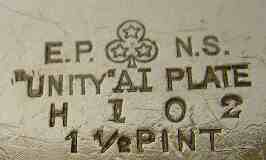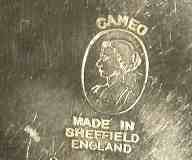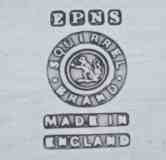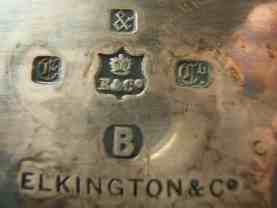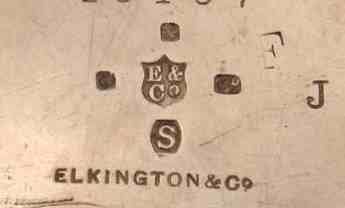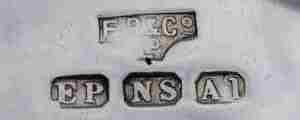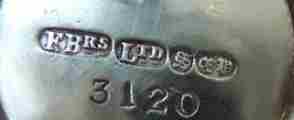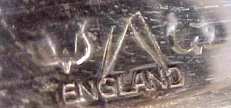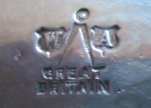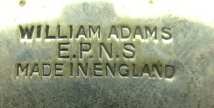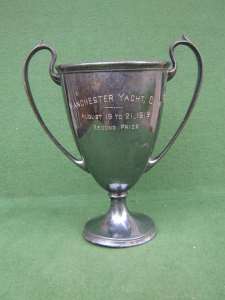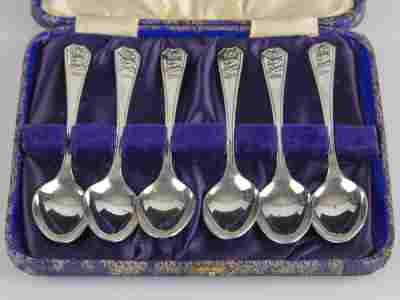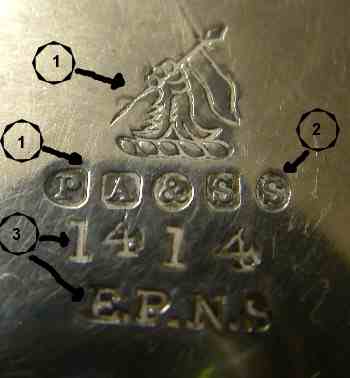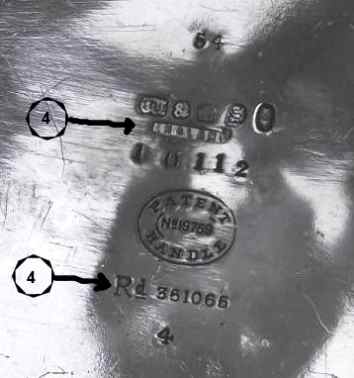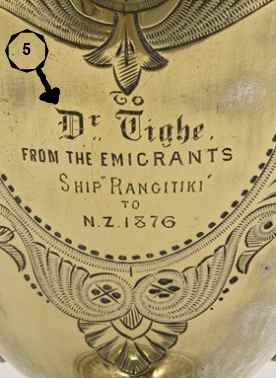A SMALL COLLECTION OF ANTIQUE SILVER |
HOW TO IDENTIFY THE MAKERThe marks of electroplated silver were often inspired to the hallmarking used for sterling
silver and the maker was identified by its initials inside a series of squares, circles, shields, etc.
|
|
|
Sometimes the initials were accompanied by an "S", standing for "Son/Sons" (if preceded by &) or "Sheffield". Boxes containing "crown", "fleur-de-lys" and other symbols were added to complete the similarity with a sterling hallmark. In other cases was used a pictorial trade mark
 |
 |
STEWART DAWSON & CO LTD
|
CULF & KAY
|
To identify the maker from its initials use the alphabetical "List of Marks" pages (see below) and follow the link:
| LISTING OF MARKS |
AA AZ |
BA BZ |
CA CZ |
DA DZ |
EA EZ |
FA FZ |
GA GZ |
HA HZ |
IA IZ |
JA JM |
JN KZ |
LA LZ |
MA OZ |
PA QZ |
RA RZ |
SA SZ |
TA UZ |
VA VZ |
WA ZZ |
When the maker's name is written in full letters use the alphabetical "Directory of Makers" (see below):
| MAKER'S HISTORY & MARK'S IMAGE |
Aa Az |
Ba Bd |
Be Bn |
Bo Bz |
Ca Cn |
Co Cz |
Da Dh |
Di Dz |
Ea Eo |
Ep Ez |
Fa Fh |
Fi Fz |
Ga Gn |
Go Gz |
Ha Hh |
Hi Hz |
Ia Jz |
Ka Kz |
La Lz |
| MAKER'S HISTORY & MARK'S IMAGE |
Ma Maq |
Mar Mz |
Na Nz |
Oa Oz |
Pa Pg |
Ph Pz |
Qa Rz |
Sa Sh |
Si Sz |
Ta Uz |
Va Vz |
Wa Wh |
Wi Wz |
Ya Yz |
Za Zz |
unk. #1 |
unk. #2 |
unk. #3 |
unk. #4 |
To identify the maker from a figural trade mark use the "Figural Trade Marks on British Silver Plate" page (see below)
|
FIGURAL TRADE MARKS ON BRITISH SILVER PLATE |









|
To identify the maker from a trade name use the "Trade Names of British Silver Plate" pages (see below)
|
TRADE NAMES OF BRITISH SILVER PLATE |



|
HOW TO DATE YOUR SILVERPLATE
From centuries British silver is protected by the stamping of symbols and letters identifying the maker, the Assay Office and the date in which the quality of the silver piece was verified.
Thanks to the "date letter" any piece of British sterling silver can be exactly dated.
Old Sheffield Plate and Electroplated silver are not subject to this practice and the regulation issued by the authorities had the main objective of preventing possible frauds by unscrupulous sellers of plated ware.
The best-known initiative is the prohibition (effective from c. 1896: Elkington was forced to change its mark in 1898) of stamping plated wares with the "crown", to avoid misunderstanding with the symbol identifying the Sheffield Assay Office.
The absence of an official dating system makes it difficult to date silver plated wares. An approximate date can be determined by examining:
- the style of the object
- the presence or absence of the crown (before or after c. 1896)
- the date of registration of the pattern at the Patent Office
- the presence of a dated dedication
- the date of the event (example: King/Queen Coronation or Jubilee commemorative spoons)
- "Ltd" or "Ld" on the mark denotes a date after 1861 (but in most cases not before 1890)
- a registered number (Rd followed by a number) denotes a date after 1883
- "England" denotes a date after 1891 (mandatory for export in the USA - McKinley Tariff Act of 1890-)
- "Made in England" denotes a 20th century date (mandatory after 1921 for export in the USA)
The largest manufacturers introduced, on a voluntary basis, a dating system of their silver plate based on series of letters of various style contained into shields or geometric figures. The first was Elkington (1841), followed by Walker & Hall (1884) and Mappin & Webb (but other less known makers tried to do something similar).
The key to decrypt Elkington date system is well known and widely illustrated in Elkington page of my website and another partial decryption is available in Walker & Hall dating page. An exclusive of this website is the page of silverplate date marks of Thomas Bradbury & Sons, lasting from 1850 to 1927 (the key, previously unknown, was deciphered by Giorgio B. in 2020).
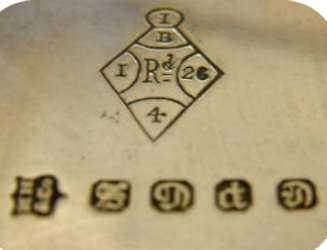 |
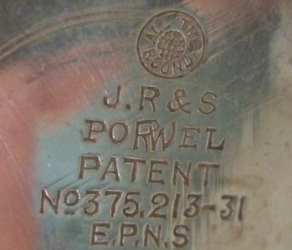 |
MARTIN HALL & CO
|
JOHN ROUND & SON
|
Silverplate manufacturers produced illustrated catalogs identifying each item with a stock or production number so that retailers could order without any confusion. These numbers were stamped on each piece (usually on the bottom). Having a catalog this number can be useful to date a piece.
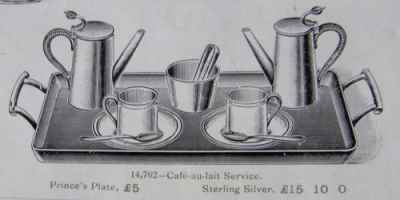
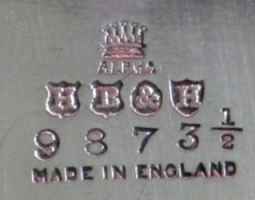
|
Stock number on MAPPIN & WEBB CATALOG (left) and HARRISON BROTHERS & HOWSON mark (right)
OTHER MARKS ON SILVERPLATE
Many other marks can be found on a silverplate piece. The most common are EPNS (Electro Plated Nickel Silver) and EPBM (Electro Plated Britannia Metal). They identify the metal alloy used as base metal for electro-deposition of silver. Further details in the EPNS/EPBM page
|
|
Other marks identifying the base metal were "EP" (ELECTRO PLATED), "BP" (BRITANNIA PLATE), "EPCA" (ELECTRO PLATED COPPER ALLOY), "EPGS"
(ELECTRO PLATED GERMAN SILVER), "EP ON COPPER" (ELECTRO PLATED ON COPPER), "ESM" (ELECTROPLATED SILVER MOUNTS), "EPWM" (ELECTRO PLATED WHITE METAL), "MP" (MAGNETO
PLATE). Further details in the ALPHABETIC SYMBOLS page
British electroplaters used a letter code for their "Plated" wares. The best quality was "A1" or "AI", lower level was "A", next level was "B",
followed by level "C", and the lowest level was "D". Further details in the ALPHABETIC SYMBOLS page


|
Often the maker's mark was accompanied by an "S" standing for Sheffield (not to be confused with the "S" standing for Son or Sons). Rarely were used other town initials as L (London), M (Manchester), G (Glasgow). Oddly I never found a "B" for Birmingham. Further details in the ALPHABETIC SYMBOLS page



|
In most cases a number, often of four figures, is stamped next the mark. This is the production/pattern/stock number used by the firm to identify the item. The same number was printed in the illustrated catalogues so that retailers could reorder the item without any confusion. Never assume these numbers as date of production of the piece.
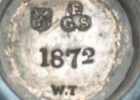
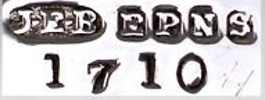
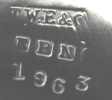
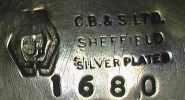
|
The workers of the plate industry were often paid on a pro rata basis. The foreman counted their output so that they could be fairly rewarded at the end of the week. In larger companies, to distinguish between each workers' ware, each member had his own punch with his initials, or, more often, with a small symbol. This mark was called the "journeyman mark" See JOURNEYMAN MARK - WORKMAN MARK page
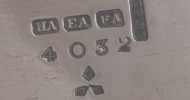
|
There was no legal requirement to mark electroplated goods and any letter, symbol or number punched in silverplate wares is part of the individual trademark used by manufacturers to customize their own production.
Silverplate was used by lower classes as an affordable substitute of sterling silver and UK makers, to gratify the ambition of their customers, often adopted punches composed of a sequence of symbols and letters similar to that used by Assay Offices for sterling silver hallmarking. This mark are called "pseudo hallmarks"
and the same symbol was used by various manufacturers so that, missing any initial or figural mark, is impossible to identify the maker.
See
PSEUDO HALLMARKS page
















|
THE FIVE "W" OF BRITISH SILVERPLATE (WHO, WHERE, WHAT, WHEN, WHY)
 www.silvercollection.it |
|
This is a page of 'The What is? Silver Dictionary' of A Small Collection of
Antique Silver and Objects of vertu, a 1500 pages richly illustrated website offering all you need to know about
antique silver, sterling silver, silverplate, Sheffield plate, electroplate silver,
silverware, flatware, tea services and tea complements, marks and hallmarks, articles,
books, auction catalogs, famous silversmiths (Tiffany, Gorham, Jensen, Elkington),
history, oddities ... HOME - SITE MAP - SILVER DICTIONARY - COOKIES CONSENT AND PRIVACY |






